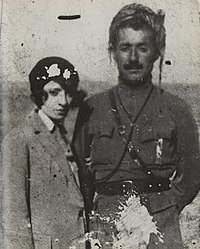Ihsan Nuri
This article needs additional citations for verification. (November 2010) |
Ihsan Nuri 1326-P. 27[citation needed] | |
|---|---|
 Ihsan Nuri and his wife Yashar | |
| Born | 1892 Bitlis, Ottoman Empire |
| Died | March 25, 1976 (aged 83–84) Tehran, Pahlavi Iran |
| Allegiance | |
| Years of service |
|
| Rank |
|
| Battles / wars | |

Ihsan Nuri, also known as Ihsan Nuri Pasha (Template:Lang-ku) (1892 or 1893, Bitlis – March 25, 1976, Tehran) was a Kurdish soldier and politician. Former officer of the Ottoman and Turkish Army. One of leaders of the Ararat rebellion as the generalissimo of the Kurdish National Forces.[2]
Early life
Ihsan Nuri was born in the house of his father Elî Qulî[3] in Bitlis in 1893. He came from a branch of the Jalali tribe. After finishing primary education at Gök Meydan mosque in Bitlis, he was registered to Erzincan Military School (Erzincan Askerî Rüştiyesi ). After completing secondary education, he entered to Ottoman Military Academy.[4] In 1910, he graduated from this academy as lieutenant and joined the Ottoman Army. He participated in the counterinsurgency operations in Albania. And then he was sent to Yemen and served there for 33 months. After returning from Yemen, he was appointed the aide-de-camp of Ottoman 93rd Infantry Regiment and was sent to Beyzon.[4] In the early stage of the First World War, he was injured at Nerman and sent back to rear area for treatment. On the way to Erzincan, he suffered from frostbite near Karaburun. After treatment in Erzincan, he was assigned to the Ottoman Ninth Army, and then he was appointed the member of the administration committee of Ozurgeti in Georgia, briefly occupied by the Turkish troops during the Caucasus Campaign of 1918[4] and served as the commander of the mobile gendarmerie of the town.[3] After the First World War, he got in contact with the Society for the Rise of Kurdistan. He wrote an article about Woodrow Wilson's Fourteen Points, and this was published on March 30, 1919 in Jîn magazine. When he arrived at Trabzon, Rushdi Bey, who was the commander of the 9th Caucasian Division, sent him to Baku to meet authorities of the Red Army.[5]
Beytussebab Rebellion
This section is empty. You can help by adding to it. (November 2010) |
Republic of Ararat
Kurdish nationalists met in October 1927 and not only proclaimed the independence of Kurdistan, but also formed Xoybûn (Independence), a “supreme national organ … with full and exclusive national and international powers”.
Cognizant of the need for a proper military structure, Xoybûn promoted Ihsan Nuri to general (pasha) and nominated him Commander-In-Chief of the Kurdish National Army. Ihsan Nuri, besides being a former Kurdish member of the Young Turks, showed his allegiance to the Kurdish cause when he led the mutiny within the Turkish military prior to the Sheikh Said rebellion.
By 1928, Ihsan Nuri had assembled a small group of soldiers armed with modern weapons and trained in infantry tactics. This force initiated the Xoybûn revolt, marching towards Mount Ararat. Ihsan Nuri and his men not only achieved success in reaching Mount Ararat, but they were able to secure the towns of Bitlis[citation needed], Van provinces, and most of the countryside around Lake Van, establishing a notable area of Kurdish resistance.
By the end of summer 1930, the Turkish air forces were bombing Kurdish positions around Mount Ararat from all directions. According to General Ihsan Nuri, the military superiority of Turkish air forces demoralized Kurds and led to their capitulation.
As refugee
During the 1930s, İhsan Nuri arrived as a refugee in Tehran. The government restricted his movements during his years in Tehran. In the summer of 1976, he was injured when he was struck by a motorcycle directly in front of his home at around 10:00 am. He was taken to a local hospital where he died of his wounds during the day. The culprit driving the motorcycle that hit him was never identified or apprehended.
Sources
- ^ Rohat Alakom, Hoybûn örgütü ve Ağrı ayaklanması, Avesta, 1998, ISBN 975-7112-45-3, p. 180. Template:Tr icon
- ^ Bletch Chirguh, La Question Kurde: ses origines et ses causes, Le Caire, Impimerie Paul Barbey, 1930, front cover, IHSAN NOURI PACHA Généralissime des forces nationales Kurdes Template:Fr icon
- ^ a b Mehmet Kemal Işık (Torî), "İhsan Nuri Paşa", Ünlü Kürt Bilgin ve Birinci Kuşak Aydınlar, Sorun Yayınları, İstanbul, Kasım 2000, ISBN 975-431-111-0, p. 169. Template:Tr icon
- ^ a b c İhsan Nuri Paşa, Ağrı Dağı İsyanı, Med Yayınları, İstanbul, 1992, p. 7. Template:Tr icon
- ^ Mehmet Kemal Işık (Torî), "İhsan Nuri Paşa", p. 170. Template:Tr icon
External links
- Ağrı Dağı İsyanı'nın lideri İhsan Nuri Paşa'yı anlatıyor, Navenda Lêkolînan Kurdistan Template:Tr icon
- Articles with empty sections from November 2010
- 1893 births
- 1976 deaths
- Kurdish people of the Ottoman Empire
- People from Bitlis
- Ottoman Military Academy alumni
- Ottoman Army officers
- Ottoman military personnel of World War I
- Turkish Kurdish people
- Turkish Army officers
- Turkish military personnel of the Turkish–Armenian War
- Turkish Kurdish politicians
- Ararat rebellion
- Generalissimos
- Pashas
- Road incident deaths in Iran
- Kurdish nationalists
- Pedestrian road incident deaths
